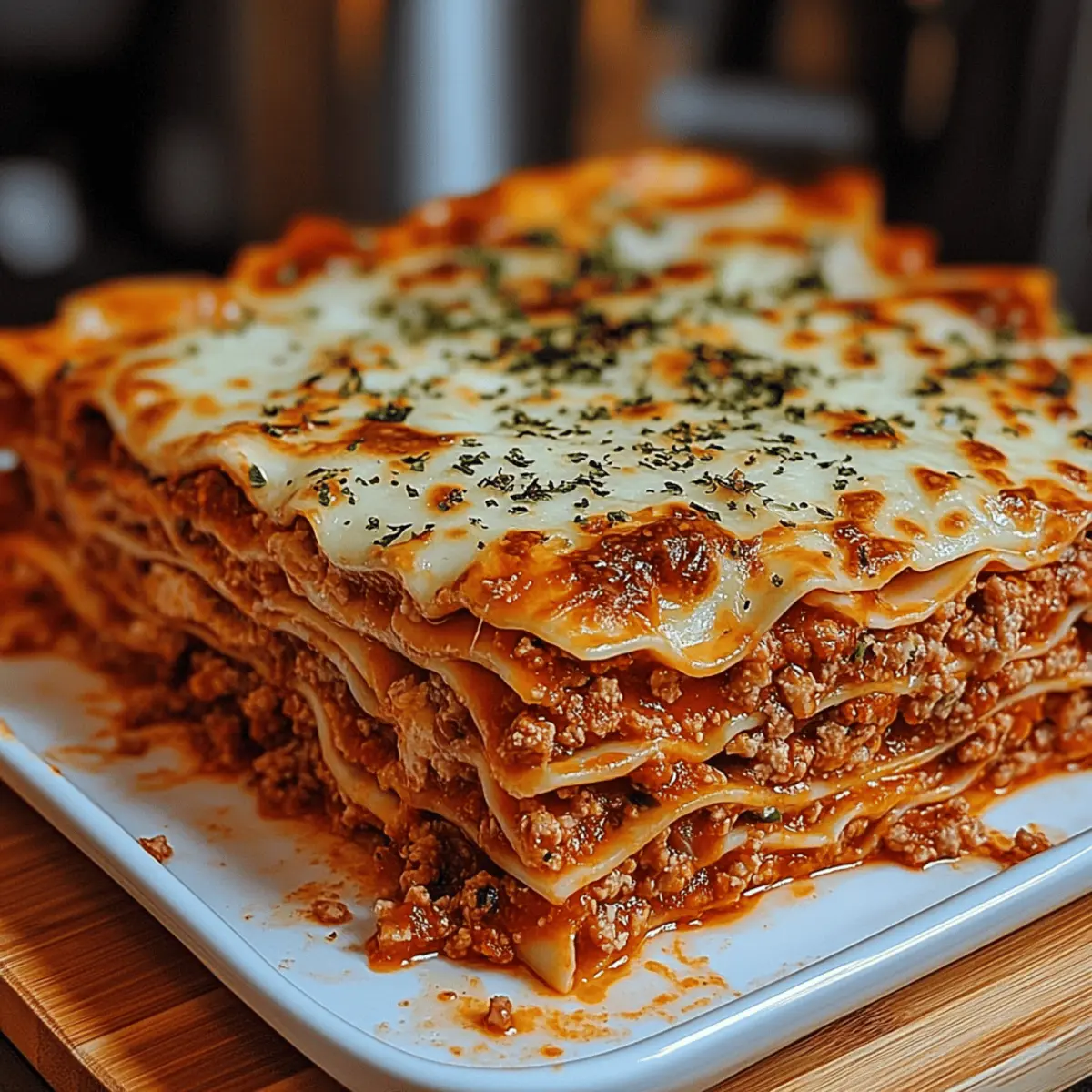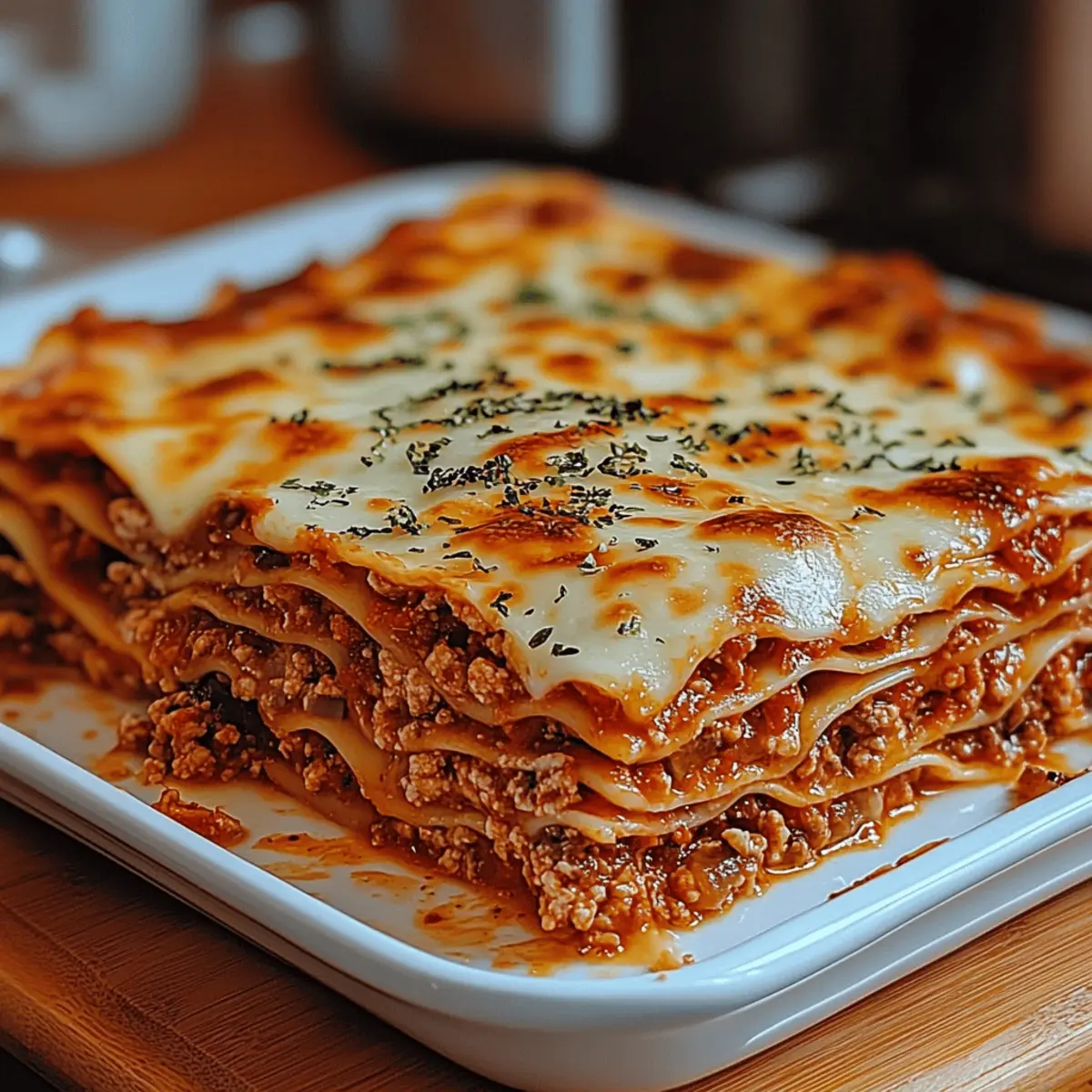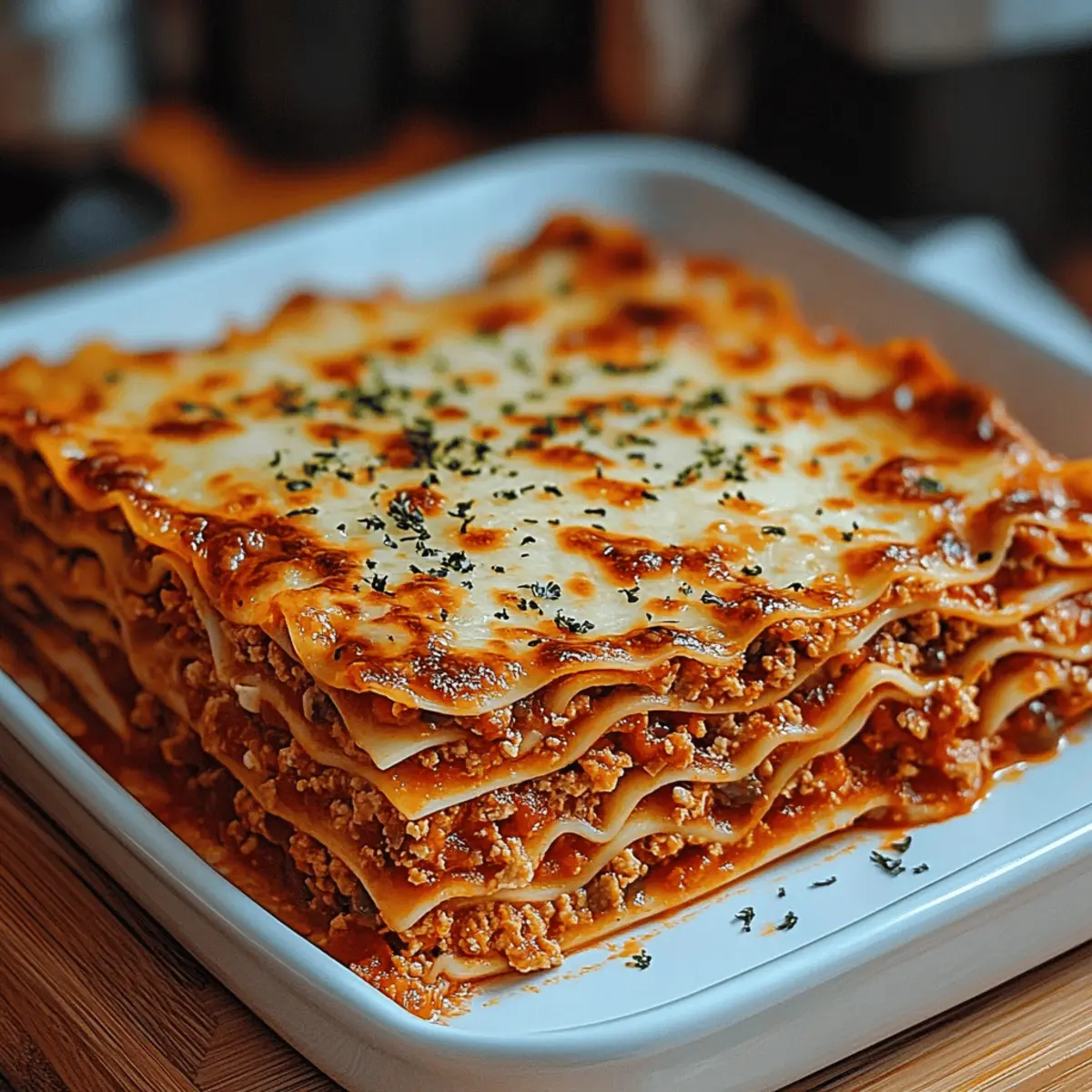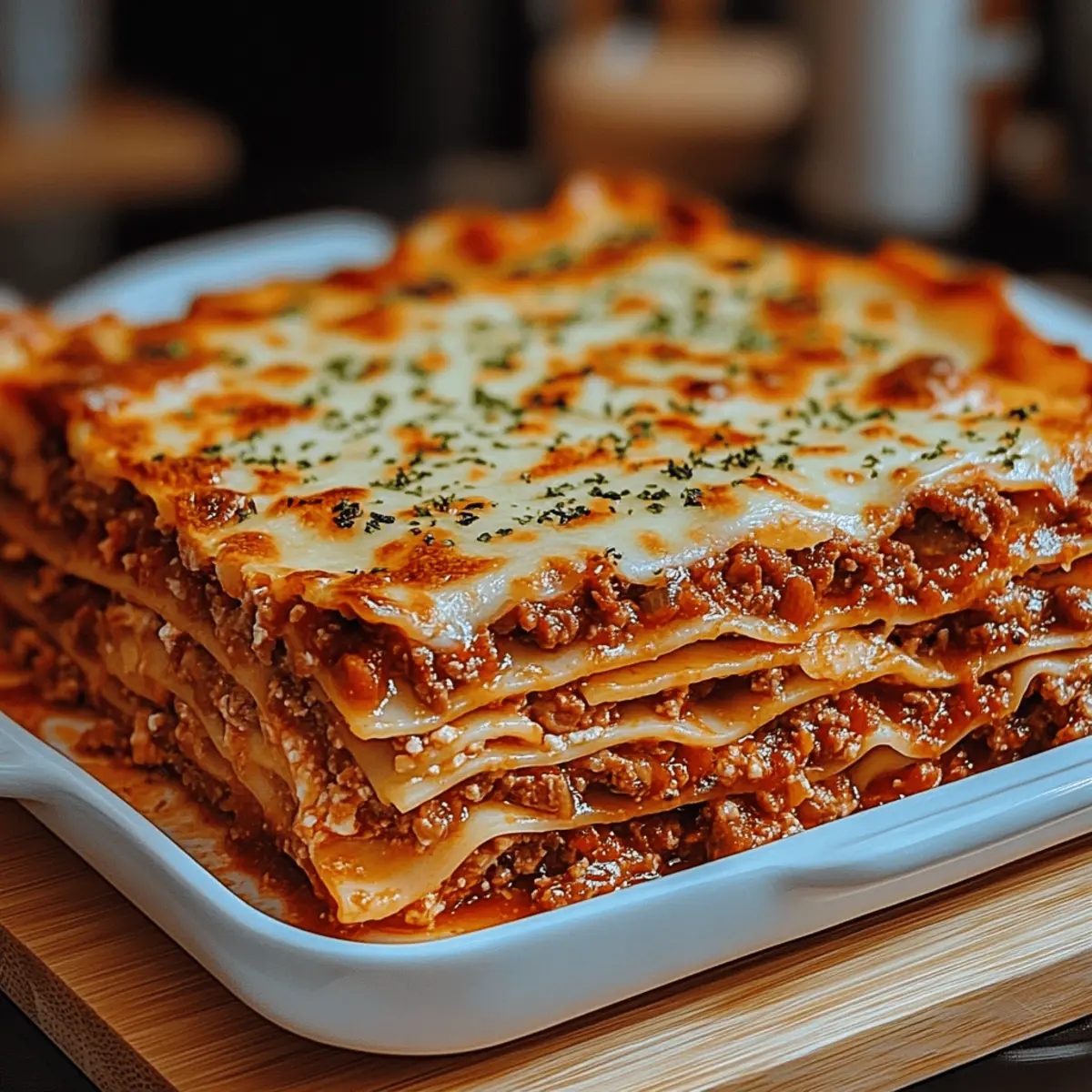As I stood in my kitchen the other day, the aroma of rich tomato sauce mingling with melting cheese danced around me, instantly transforming my space into an Italian trattoria. Nothing says love quite like homemade lasagna, where layers of tender pasta encase a savory filling that can be tailored to whatever your heart (or fridge) desires. This comforting lasagna recipe not only satisfies cravings with its customizable options—from hearty meats to rich roasted vegetables—but it's also easy enough to whip up for a quick weeknight dinner yet impressive enough to steal the show at gatherings. Curious how a few simple ingredients can create such a beloved classic? Let’s dive into the delicious details!

Why is homemade lasagna so special?
Layers of Flavor: Each slice boasts rich, savory layers of beef, creamy cheeses, and fragrant herbs, creating a delightful explosion of taste.
Customizable Goodness: Whether you prefer a classic meat version or a vibrant vegetarian twist with roasted veggies, this recipe offers endless possibilities.
Quick Yet Impressive: Perfect for busy weeknights or special occasions, it looks and tastes gourmet without requiring advanced cooking skills.
Crowd-Pleasing Comfort: Nothing brings people together quite like a homemade lasagna, making it ideal for family gatherings or dinner parties.
Easy Make-Ahead: Prep ahead and savor the flavors even more. Store unbaked lasagna in the fridge overnight for a convenient meal.
Lasagna Ingredients
For the Sauce
- Olive oil – Adds richness and helps sauté the vegetables; you can substitute with vegetable oil for a lighter option.
- Onion – Provides a savory base flavor; any onion variety works, though yellow onions are preferred.
- Garlic – Adds a fragrant, aromatic punch to the sauce; fresh garlic is recommended, but powdered garlic can work in a pinch.
- Ground beef (or mix with Italian sausage) – Main protein source for the sauce; swap for turkey for a leaner option or use plant-based ground meat for a vegetarian version.
- Dried oregano, basil, and thyme – Herbs that infuse the sauce with Italian flavor; using fresh herbs can elevate the taste but adjust the amounts accordingly.
- Red pepper flakes – Optional for heat; adjust to taste for your preferred spice level.
- Crushed tomatoes, tomato sauce, and tomato paste – Essential for the savory, rich sauce; for a fresher taste, use diced fresh tomatoes.
- Dry red wine – Adds depth to the sauce; omit for a non-alcoholic version.
- Sugar – Balances acidity in the sauce; honey or a sugar substitute can be used.
For the Filling
- Ricotta cheese – Gives creaminess to the filling; substitute with cottage cheese for a lower-fat option.
- Parmesan cheese (grated) – Adds a nutty flavor that enhances both filling and topping.
- Fresh parsley – Enhances flavor and adds color; basil can be a substitute for a different flavor profile.
- Egg – Binds the ricotta filling; omit for a vegan version or use flax egg as a substitute.
For the Topping
- Shredded mozzarella cheese – Provides a delicious gooey topping; can be replaced with any melting cheese for varied flavor.
For Assembly
- Lasagna noodles – Core structure of the dish; use oven-ready noodles for convenience or regular noodles, cooked al dente, for best results.
Step‑by‑Step Instructions for Homemade Lasagna
Step 1: Sauté the Base
In a large skillet, heat 2 tablespoons of olive oil over medium heat. Add 1 chopped onion and cook until soft, about 5 minutes. Stir in 2 minced garlic cloves, cooking for an additional 1-2 minutes until fragrant. This aromatic base is essential for creating the rich flavor profile of your homemade lasagna.
Step 2: Brown the Meat
Add 1 pound of ground beef (or a mix with Italian sausage) to the skillet. Cook until browned, breaking it apart with a spoon, approximately 6-8 minutes. Drain any excess grease, leaving the flavorful bits behind to enhance the sauce. The meat should be nicely caramelized to provide depth in your lasagna.
Step 3: Stir in Seasonings
Sprinkle in 1 teaspoon each of dried oregano, basil, and thyme, along with a pinch of red pepper flakes for heat. Stir well for about 1 minute to bloom the spices, allowing them to infuse the meat mixture. This step is crucial, as the herbs will elevate the flavor of your homemade lasagna.
Step 4: Build the Sauce
Pour in 28 ounces of crushed tomatoes, 8 ounces of tomato sauce, and 2 tablespoons of tomato paste. Add ½ cup of dry red wine (or omit if preferred), along with 1 teaspoon of sugar, and season with salt and pepper to taste. Simmer the sauce uncovered for at least 30 minutes, stirring occasionally until thickened and flavorful.
Step 5: Prepare the Cheese Mixture
While the sauce simmers, whisk together 15 ounces of ricotta cheese, ½ cup of grated Parmesan cheese, and 1 egg in a mixing bowl. Stir in 2 tablespoons of chopped fresh parsley and a pinch of salt and pepper. This creamy cheese mixture will create delightful layers in your lasagna.
Step 6: Preheat the Oven
Preheat your oven to 375°F (190°C) to ensure it’s hot and ready for baking. Meanwhile, prepare a 9x13 inch baking dish by lightly greasing it to prevent sticking. Having everything ready will streamline the assembly process of your homemade lasagna.
Step 7: Layer the Ingredients
Start layering by spreading a thin layer of the meat sauce on the bottom of the baking dish. Place a layer of lasagna noodles over the sauce, followed by half of the ricotta mixture and a sprinkle of shredded mozzarella cheese. Repeat this layering process, ending with a layer of sauce and a generous topping of mozzarella.
Step 8: Final Layer and Bake
Cover the assembled lasagna with aluminum foil, making sure it doesn’t touch the cheese. Bake in the preheated oven for 30 minutes. After this time, carefully remove the foil to allow the cheese to brown, and bake for an additional 15-20 minutes, until the top is bubbly and golden.
Step 9: Let it Rest
Once your homemade lasagna is out of the oven, let it rest for at least 15-20 minutes. This resting period helps the layers to set, making it easier to slice. As you wait, the flavors meld beautifully into each delightful serving.
Step 10: Serve and Savor
Using a sharp knife, cut the lasagna into squares and serve warm alongside a fresh green salad and garlic bread. Each slice showcases the beautiful layers of the rich sauce, creamy cheeses, and tender noodles, making for a perfect dinner that will impress family and friends.

Make Ahead Options
Homemade lasagna is an excellent candidate for meal prep! You can assemble the entire dish up to 24 hours in advance by layering the sauce, noodles, and cheese without baking. Simply cover it tightly with foil and refrigerate to maintain freshness. If you need to prepare it even earlier, you can freeze the unbaked lasagna for up to 3 months; just be sure to wrap it well in plastic wrap before placing it in an airtight container. When you're ready to bake, thaw it overnight in the refrigerator and then cook according to the recipe instructions. This way, you’ll enjoy a comforting and delicious homemade lasagna with minimal effort on busy nights!
Lasagna Variations & Substitutions
Feel free to get creative with your lasagna; these ideas will inspire you to make it uniquely yours!
-
Meat Options: Swap ground beef for ground turkey or a plant-based alternative for a lighter or vegetarian dish that retains all the flavors you love.
-
Veggie Boost: Add diced zucchini, spinach, or mushrooms between the layers for an extra veggie punch that enhances the nutrition and color of your lasagna.
-
Cheese Change: Experiment with different cheeses like provolone or gouda for a delightful twist on traditional flavors. Each cheese brings its own unique richness and depth.
-
Sauce Upgrade: Use homemade marinara instead of canned versions for a fresher taste, or add sun-dried tomatoes for an extra depth of flavor that transforms your sauce into something extraordinary.
-
Herb Experimentation: Try adding fresh basil or rosemary to the meat sauce for an aromatic uplift. Don’t be afraid to mix and match herbs to find your perfect balance!
-
Gluten-Free Option: Use gluten-free lasagna noodles or zucchini slices for a delicious gluten-free lasagna that everyone can enjoy without sacrificing taste.
-
Spice It Up: If you love heat, sprinkle in some diced jalapeños or a dash of hot sauce to the meat mixture for a fiery version that’s sure to tantalize your taste buds.
-
Creamy Twist: Mix ricotta with pesto for a herby, creamy filling that elevates the overall flavor. This playful variation is a real crowd-pleaser!
For other inspiration, you can explore how to take your lasagna-making skills to new heights by following this easy make-ahead plan that allows you to prep more efficiently, or consider serving your luscious lasagna with a fresh green salad to complement its hearty goodness.
What to Serve with Homemade Lasagna
Nothing complements the warm, hearty flavors of lasagna quite like the right side dishes and beverages.
- Garlic Bread: Perfectly crispy and buttery, this classic side enhances the savory notes of your lasagna while offering a delightful crunch to each bite.
- Caesar Salad: Crisp romaine, tangy dressing, and crunchy croutons add a refreshing contrast, balancing the richness of the lasagna beautifully.
- Roasted Vegetables: Seasonal vegetables like zucchini, bell peppers, and asparagus add vibrant colors and nutrients. Their caramelized edges provide a delightful texture that pairs well with the cheesy layers.
- Antipasto Platter: An assortment of olives, cheeses, and cured meats brings a burst of flavor, inviting guests to mingle and enjoy before the main course.
- Tiramisu: This luscious coffee-flavored dessert ends the meal on a sweet note, echoing the Italian theme and whisking you away to a cafe in Rome.
- Red Wine: A smooth Chianti or a robust Montepulciano enhances the flavors of the dish, elevating your homemade experience to rustic Italian dining.
- Steamed Broccoli: Light and nutritious, broccoli adds a pop of green that contrasts the richness of lasagna, providing balance and a touch of healthiness.
- Caprese Salad: Juicy tomatoes, creamy mozzarella, and fragrant basil add freshness, making it an elegant pairing that complements the warm, hearty lasagna.
- Zesty Lemonade: A chilled glass of homemade lemonade refreshes the palate, cutting through the richness of the cheese and inviting another bite of lasagna.
How to Store and Freeze Lasagna
Fridge: Store leftover homemade lasagna in an airtight container in the fridge for up to 3 days. Reheat in the oven at 350°F (175°C) for best results.
Freezer: For long-term storage, wrap unbaked lasagna tightly in plastic wrap and aluminum foil. It can be frozen for up to 3 months.
Reheating: To reheat from frozen, thaw in the fridge overnight, then bake at 350°F (175°C) for about 45 minutes until heated through.
Make-Ahead: Prepare your lasagna a day in advance and keep it unbaked in the fridge. This lets the flavors develop, making your homemade lasagna even more delicious!
Expert Tips for the Best Lasagna
- Layer Wisely: Ensure even distribution of sauce, noodles, and cheese to maintain structural integrity. This is key for a successful lasagna.
- Don't Rush the Resting: Allow the lasagna to rest for 15-20 minutes before slicing. This helps the layers set and makes for cleaner pieces.
- Taste Your Sauce: Always taste and adjust your seasonings before assembling. A well-seasoned sauce is the heart of great lasagna.
- Noodle Precautions: If using traditional noodles, cook them al dente to avoid a mushy texture in the final dish. Oven-ready noodles are a great shortcut!
- Customize Flavor: Feel free to experiment with herbs and spices, or add roasted vegetables for a personal touch that elevates your lasagna experience.

Homemade Lasagna Recipe FAQs
How do I select ripe tomatoes for the sauce?
Absolutely! When choosing ripe tomatoes, look for ones that are deep red in color, firm yet slightly yielding to gentle pressure, and free from dark spots or blemishes. If using canned tomatoes, opt for those labeled "San Marzano" or those that mention being packed in their juices for a richer flavor.
How should I store leftover lasagna?
Lasagna can be stored in an airtight container in the refrigerator for up to 3 days. Be sure to let it cool to room temperature before sealing it to prevent condensation. When reheating, cover it with foil in the oven set at 350°F (175°C) to maintain moisture and ensure even heating.
Can I freeze lasagna, and if so, how?
Very! To freeze, wrap your unbaked lasagna tightly in plastic wrap followed by aluminum foil, or place it in a freezer-safe container. This keeps it fresh for up to 3 months. When you’re ready to enjoy it, thaw overnight in the fridge and heat in the oven at 350°F (175°C) for about 45 minutes or until hot and bubbly.
What can I do if my lasagna turns out too watery?
If your lasagna is too watery, it's likely due to excess sauce or cooking liquid. Here’s how to fix it: After assembling, allow the lasagna to rest for 20 minutes before slicing, which will help the layers set. Additionally, try using less sauce next time or thicken your sauce by simmering it longer with the lid off.
Are there any dietary considerations for this lasagna recipe?
I often make variations to cater to dietary needs! For a gluten-free option, swap traditional noodles for gluten-free lasagna sheets. For those with dairy allergies, you can use a dairy-free ricotta made from nuts or tofu, and substitute the cheese with a plant-based alternative. Always check labels to ensure no hidden allergens are included!
How can I make lasagna ahead of time?
Sure! You can prep your homemade lasagna a day in advance. Assemble the layers, but do not bake it. Cover the unbaked dish with plastic wrap and refrigerate. This way, the flavors meld beautifully. When you’re ready, just pop it in the oven straight from the fridge; it may need an extra five to ten minutes of baking time!

Indulgent Lasagna: Your Ultimate Comfort Food Adventure
Ingredients
Equipment
Method
- In a large skillet, heat 2 tablespoons of olive oil over medium heat. Add 1 chopped onion and cook until soft, about 5 minutes. Stir in 2 minced garlic cloves, cooking for an additional 1-2 minutes until fragrant.
- Add 1 pound of ground beef to the skillet. Cook until browned, breaking it apart with a spoon, approximately 6-8 minutes.
- Sprinkle in 1 teaspoon each of dried oregano, basil, and thyme, along with a pinch of red pepper flakes. Stir well for about 1 minute.
- Pour in 28 ounces of crushed tomatoes, 8 ounces of tomato sauce, and 2 tablespoons of tomato paste. Add ½ cup of dry red wine, 1 teaspoon of sugar, and season with salt and pepper. Simmer uncovered for at least 30 minutes.
- While the sauce simmers, whisk together 15 ounces of ricotta cheese, ½ cup of grated Parmesan cheese, and 1 egg in a mixing bowl. Stir in 2 tablespoons of chopped fresh parsley.
- Preheat your oven to 375°F (190°C) and prepare a 9x13 inch baking dish by greasing it.
- Start layering by spreading a thin layer of the meat sauce on the bottom of the baking dish. Place a layer of lasagna noodles over the sauce, followed by half of the ricotta mixture and a sprinkle of shredded mozzarella cheese.
- Cover the assembled lasagna with aluminum foil and bake for 30 minutes. Then remove the foil and bake for an additional 15-20 minutes.
- Once out of the oven, let your lasagna rest for at least 15-20 minutes before slicing.
- Cut the lasagna into squares and serve warm with a fresh green salad and garlic bread.





Leave a Reply